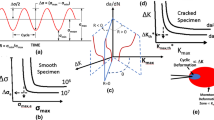Abstract
A particular form of a probabilistic model for materials under fatigue which embodies Weibull features and the size effect in a weakest-link framework is derived. The parametric and functional form of the model arises from a certain set of assumptions, as the weakest-link principle, stability, limit behavior, limited range and compatibility, which can be justified as being consistent with experimental features of fatigue (mainly of highly drawn steel wires) and the mathematics of extreme value theory. These assumptions, which are discussed, can be used to rule out other possible forms as being fundamentally inconsistent. The authors also discuss estimation procedures for the parameters based on two steps: a non-linear regression step, in which the threshold lifetime and stress range values are determined, and a second step in which the Weibull parameters are estimated by pooling data from different stress levels and using a probability-weighted moments approach or the Castillo-Hadi estimators. Next, the damage accumulation problem is dealt with and two different proposals for the damage index are given. The model, originally developed to handle a fixed load parameter (such as the stress range in cyclic fatigue), is extended to handle a block load sequence involving many load levels, as well as random load programs. Some formulas for calculating the accumulated damage index for constant, block and random loading are given. Finally, the model and methods are applied to a particular fatigue program on concrete to illustrate all concepts and the practical use of formulas.
Similar content being viewed by others
References
Bolotin, V.V. (1981). Wahrscheinlichkeitsmethoden zur Berechnung von Konstruktionen, VEB Verlag.
Castillo, E. (1988). Extreme Value Theory in Engineering. Academic Press, New York.
Castillo, E. and Galambos, J. (1987). Lifetime regression models based on a functional equation of physical nature. Journal of Applied Probability, 24, 160-169.
Castillo E. and Hadi, A.S. (1994). Parameter and quantile estimation for the generalized extreme-value distribution. Environmetrics 5, 417-432.
Castillo, E., Fernández Canteli, Esslinger, V. and Thürlimann, B. (1985). Statistical Model for Fatigue Analysis of Wires, Strands and Cables. IABSE Periodica, 1.
Coleman, B.D. (1958). Statistics and time dependence of mechanical breakdown in fibers. Journal of Applied Physics 29, 968-983.
Diaconis P. and Efron B. (1983). Computer intensive methods in Statistics. Scientific American 248, 116-130.
Efron, B. (1979). Bootstrap methods: another look at the jackknife. The Annals of Statistics 7, 1-26.
Fernández Canteli, A. (1982). Statistical interpretation of the miner-number using an index of total damage. IABSE Colloquium, Lausanne.
Greenwood, J.A., Landwehr, J.M., Matalas, N.C. and Wallis, J.R. (1979). Probability weighted moments: definition and relation to parameters of several distributions expressible in inverse form. Water Resources Research 15, 1049-1054.
Holmen, J.O. (1979). Fatigue of Concrete by Constant and Variable Amplitude Loading. The Norwegian Institute of Technology, University of Trondheim.
Hosking, J.R.M., Wallis, J.R. and Wood, E.F. (1985). Estimation of the generalized Pareto distribution by the method of probability-weighted moments. Technometrics 27, 251-261.
Jenkinson, A.F. (1969). Statistics of Extremes, Technical Note 98. World Meteorological Office, Geneva.
Prescott, P. and Walden, A.T. (1980). Maximum likelihood estimation of the parameters of the generalized extreme-value distribution. Biometrika 67, 723-724.
Prescott, P. and Walden, A.T. (1983). Maximum likelihood estimation of the parameters of the three-parameter generalized extreme-value distribution. Journal of Statistical Computing and Simulation 16, 241-250.
Smith, R.L. (1985). Maximum likelihood estimation in a class of nonregular cases. Biometrika 72, 67-90.
Author information
Authors and Affiliations
Rights and permissions
About this article
Cite this article
Castillo, E., Fernández-Canteli, A. A general regression model for lifetime evaluation and prediction. International Journal of Fracture 107, 117–137 (2001). https://doi.org/10.1023/A:1007624803955
Issue Date:
DOI: https://doi.org/10.1023/A:1007624803955




